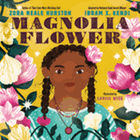
Freedom forges a path to love in National Book Award-winner Ibram X. Kendi's lyrical picture book adaptation of Magnolia Flower, a short story by Zora Neale Hurston first published in 1925.
The Brook is desperate for a story and the Mighty River, knowing "brooks must be humored," tells one. "Long ago," the Mighty River begins, strong Bentley fled enslavement. "Soon a whole village of runaways" grew around him and he married "Swift Deer,/ a Cherokee woman who had fled/ her own trail of tears." They named their daughter Magnolia Flower "for she came at the time of the flowers opening." The girl grows as the Civil War rages, falls in love and eventually defies her father, fleeing down the Mighty River with her beloved. Nearly 50 years later, the lovers return to the River to find the spot where the River meets the Brook.
Hurston's extensive catalogue of work is focused heavily on the beauty and struggles of the Black lived experience. Kendi (Stamped: Racism, Antiracism, and You) uses poetic and accessible prose to restate Hurston's historical truths. Kendi's adaptation retains a strong presence of the natural world, another prominent element in Hurston's writing. His textual personification of the surrounding environment is delicately and subtly conveyed through Loveis Wise's illustrations. Wise (The People Remember) does not use human attributes for the natural world, instead placing the river, the trees, at the center of sprawling scenes. Their gentle digital illustrations have a vivaciousness that reinforces the depth of Hurston's characters as well as the vastness of the world encompassing them. --Rachel Werner, author and teaching artist at Hugo House, Lighthouse Writers Workshop and The Loft Literary Center

